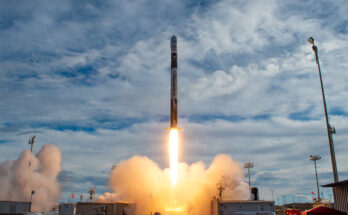By Bill Ostrove, Space Systems Analyst, Forecast International.
Virgin Galactic recently announced upgrades to its LauncherOne launch vehicle. When Virgin Galactic initially announced development of LauncherOne, the company said it planned to develop a vehicle capable of carrying 120-kilogram payloads to a sun-synchronous orbit for about $10 million. The company has now increased that capability to 200 kilograms for the same price.
LauncherOne is being designed to carry small satellites, or SmallSats, into orbit. The market for SmallSats has expanded rapidly in recent years, and is expected to continue to grow. The reduction in the size of computer components is allowing governments and companies to build much smaller satellites than they have in the past. The small size can reduce costs significantly. These reduced costs are making SmallSats appealing for commercial, civil government, university, and defense users.
However, despite the growing popularity of SmallSats, one issue that remains is the high cost of transporting the satellites to space. One way to reduce these costs is to launch SmallSats as secondary payloads on larger launch vehicles. The drawback of that method is that the primary payloads take precedence when scheduling flights, with SmallSat operators losing flexibility when determining deployment times.
In response, new companies are jumping into the market to address SmallSat launch service needs. Spaceflight Industries, for example, is developing a cargo craft – called the Sherpa – that will launch aboard a larger rocket and then deploy satellites in space.
However, most companies getting into this market are developing small launch vehicles. The three primary competitors are Rocket Lab, Firefly Space Systems, and Virgin Galactic. Rocket Lab’s entry will be the smallest of the competing vehicles, and will carry about 100 kilograms to low-Earth orbit (LEO). Firefly will develop a launch vehicle capable of carrying 400 kilograms to LEO and 175 kilograms to sun-synchronous orbit. With the announced upgrades, LauncherOne will have the highest launch mass capability. All companies are targeting a price tag of about $8 million to $10 million for launch services.
The real question is, what is the market for these small launch vehicles? On the one hand, there seems to be a real clamor within the industry for small launch vehicles that can accommodate SmallSats with a flexible launch schedule at low prices. That said, the market for SmallSats has grown rapidly even without these capabilities. Going forward, rideshare programs will likely continue to be cheaper than dedicated launch vehicles. For example, Spaceflight Industries advertises rideshare prices of $5.95 million to carry a 200-kilogram payload to LEO – significantly cheaper than the $8-$10 million advertised by small launch vehicle developers.
Like airline passengers, SmallSat operators may decide to trade the flexibility of small launch vehicles for the low prices of rideshare arrangements.
Another alternative is the use of both small launch vehicles and rideshare arrangements. The SmallSat market is large and continues to grow. More than 90 SmallSats launched in 2014, and 60 have launched so far in 2015. At the same time, startups like Planet Labs and OneWeb are developing plans for constellations with hundreds of satellites. There will therefore likely be a market for both rideshare arrangements and small launch vehicles. Companies that have investors will need to start generating revenue, and they will need satellites to do that. Small launch vehicles will provide companies with the flexibility needed to get spacecraft into orbit quickly. They could also be used to quickly replace satellites that fail in orbit. Rideshare arrangements, meanwhile, can be used to carry the bulk of satellites to orbit for relatively low prices.
It is unclear which small launch vehicles will eventually be successful in the market. However, considering the promise of the small satellite market, it is likely that at least one or two small launch providers will succeed.
Want market intelligence from Forecast International delivered right to your inbox? Click the link to sign up for our “World Aerospace & Defense Intelligence” Newsletter!
A military history enthusiast, Richard began at Forecast International as editor of the World Weapons Weekly newsletter. As the Internet grew in importance as a research tool, he helped design the company's Forecast Intelligence Center and currently coordinates the EMarket Alert newsletters for clients. Richard also manages social media efforts, including two new blogs: Defense & Security Monitor, covering defense systems and international issues, and Flight Plan, which focuses on commercial aviation and space systems. For over 30 years, Richard has authored the Defense & Aerospace Companies, Volume I (North America) and Volume II (International) services. The two books provide detailed data on major aerospace and defense contractors. He also edits the International Contractors service, a database that tracks all the contractors involved in the programs covered in the FI library. More recently he was appointed Manager, Information Services Group (ISG), a new unit that encompasses developing outbound content for both Forecast International and Military Periscope.




